Artists tasked with filling the US Pavilion at the Venice Biennale have often poked at its resemblance to Monticello, the plantation designed by the slave-owning third U.S. president. “Mini-Monticello,” Sarah Sze called the pavilion in 2013, commenting on how awkward its smallness made its grandeur. Vito Acconci wrote a scrambled, sprawling consideration of Thomas Jefferson’s architectural legacy, wondering how often Sally Hemings, the president’s slave and mother of six of his children, had access to the main house. Mark Bradford, whose work currently occupies the pavilion for the 57th Biennale, closed off the front entrance. Staffers smoke in front of it on their breaks. Visitors enter from the side, where slaves might have entered (as I heard one attendant explain to a confused viewer), and immediately encounter Spoiled Foot (2017), a painted, room-sized collage that looks like a boil growing down from the ceiling. The press releases for Bradford’s Venice installation glow with praise, both for his material acuity and social vision:
Bradford renews the traditions of abstract and materialist painting, demonstrating that freedom from socially prescribed representation is profoundly meaningful in the hands of a black artist. […] Tomorrow is Another Day is a narrative of ruin, violence, agency, and possibility, a story of ambition and belief in art’s capacity to engage us all in urgent and profound conversations, and even action.
This has the cadence of a hero’s narrative, especially when paired with tales of the artist’s social causes. On April 29, two weeks before the Biennial’s official opening, Bradford celebrated a new pop-up retail center in Venice stocked with handiwork by female prisoners and a limited-edition bag he designed. Bradford funded the pop-up, and all proceeds go to Rio Terà dei Pensieri, a non-profit that employs incarcerated women. “I don’t know if we’ve seen someone with the dexterity of De Kooning who is also committed to activism,” Christopher Bedford, co-curator of the U.S. Pavilion, told the LA Times, when the U.S. State Department announced that Bradford would represent the country. “That is unique to art,” he continued, echoing a widely-held artworld assumption that abstraction is typically not socially conscientious. The article, like nearly every article on Bradford’s Biennale selection, mentioned Art + Practice, the “social services organization and art gallery” Bradford and two collaborators (Allan DiCastro, Eileen Norton) founded in the Los Angeles neighborhood of Leimert Park. An ambitious brick-and-mortar space like this lessens the apparent gap between art-in-gallery and an artist’s social commitment. But in a rapidly gentrifying neighborhood with a dense cultural history, such efforts were destined to be fraught.
Art + Practice (A+P) officially opened in February 2015 in Leimert Park Village, the walking-friendly social center of a planned neighborhood just south of the I-10 Freeway. In Leimert, David Hammons, Noah Purifoy, and Romare Bearden all had memorable Los Angeles exhibitions in the 1960s and ‘70s. Members of the Pan-Afrikan People’s Arkestra have rehearsed and performed at The World Stage jazz venue – and in the local park – since the ‘80s. Eso Won Books, the Leimert-based shop named after a town along the Nile, is a “safe haven,” a protector of the “concept of community,” as journalist Lynell George wrote in a 2015 article for Journal of Pan African Studies. High art and grassroots community have a history of merging here. So it seemed plausible that, at a moment when a coming Metro stop and rising home prices make residents’ economic futures uncertain, Bradford’s non-profit would continue an endangered tradition of artists putting the local first.
Before it opened, A+P announced a partnership with the Hammer Museum, based in Westwood. The museum had received a $600,000 grant from the Irvine Foundation to create a “new model” to “increase arts access and engagement for residents of African American communities within South Los Angeles,” and its curators would program the gallery for the first two years. The grant language was subtly condescending, as such language often is. Certainly the Hammer’s programming has not been easily accessible to residents South Los Angeles – known as South Central before a city council vote dropped “Central” to liberate the area from stereotypes – but many neighborhoods, notably this one, have long developed local ways of “increasing arts access.”
A+P’s gallery was originally on Leimert Boulevard, in Bradford’s former studio, right next to the building that housed The Right Way Foundation’s program, which helps young, former foster youth transition into employment. Later, the gallery moved to larger accommodations in a former beauty supply store around the corner on Degnan, reserving the Leimert Boulevard buildings for social services. A+P’s office was on Degnan too, and they were slowly renovating an Art Deco building on the corner of Degnan and 43rd Place. They’d acquired, just to the naked eye, a lot of real estate.
Unbeknownst to most L.A. artworlders, certain tenants in Leimert Park Village had been, since 2012, fighting to learn the identity of their new landlord, a mystery figure refusing to renew leases. The 25-year-old jazz venue on Degnan, The World Stage, hosted a benefit concert to raise awareness of their precarious real-estate situation in October 2013 and called councilman Herb Wesson repeatedly. When the LA Times ran an article introducing A+P and making it sound as though they owned much of the block, The World Stage board was sure they’d solved the mystery. Dwight Trible, director of The World Stage, wrote an email to A+P asking for a sit-down with Bradford. “Artist-to-artist,” he said, they could discuss the future of the Stage, which occupied a building he believed Bradford owned. He wanted to negotiate a new lease, but says he was informed, via email by Bradford’s partner Allan DiCastro, that he was mistaken; A+P did not own his building and Bradford did not have time for a sit-down. When I asked Sophia Belsheim, Art+Practice’s office administrator, if A+P indeed owned the line of buildings along Degnan, long occupied by art spaces like the Stage and black-owned boutiques, I was told that they were trying to “dispel that rumor,” and that Art+Practice did not know who owned these buildings.
My search through public records revealed that Bradford and DiCastro had bought the property along that block through an LLC a month after the Metro board approved the new Leimert Park stop. A+P rents from the same LLC, with property management company Clint Lukens as intermediary. None of this is out of the ordinary for real-estate investors – distancing themselves from liability via intermediaries – and DiCastro and Bradford have been investing in West Adams and South L.A. over the past decade. What was confusing was the secrecy, especially given the tagline “Art+Practice fosters community.” Later, when I clarified my question and asked if either Bradford or DiCastro owned the properties in question, the founders of A+P refused to comment. (They did not respond to requests for comment during the reporting of this piece, either.)
“Say I go into Inglewood and I buy up Market Street,” says Leimert-based activist Damien Goodmon, by way of example, during a recent conversation in Leimert Village. Market Street is, like the Village, an autonomous-feeling town center further south in L.A. “If I’m doing this for the community, I explain what’s up. I take suggestions. How do I make sure people feel involved? I have a dialogue.” He insists he’d do it this way, despite the inevitable complications, if he wanted community members to have agency, above all.
In this neighborhood, awaiting its new Metro stop and increasingly attractive to speculators and developers, suspicion of newcomers and the change they bring runs high. As a white woman, my own presence in the neighborhood has been identified with that change. “Can I say something?” said man who rolled down his window one night, as a friend and I strolled toward our cars. “You walking here, this late at night? Changing times. Changing times.”
“It’s going to be gone in four years – people aren’t fighting and standing up,” says Franco Vega, director of the Right Way Foundation, about Leimert Village’s generous community culture (he mentions the barber who offers $10 haircuts for foster youth). “But I’ve got other wars to fight.” We are sitting in Vega’s new windowless office, in the Crenshaw mall. The Foundation moved here after A+P gave them notice late in summer 2016. This new space, just blocks away from the old one, and still in the area of L.A. that Vega calls “ground zero” for foster youth, has doors that open onto the parking garage. Vega had emailed me in frustration when he learned he had to move: he had assumed there would be an option to renegotiate a lease after his two rent-free years were up.
“Education has the power to counterweigh [foster youth’s] long history of abuse,” reads A+P’s year-two catalogue of achievements, the text superimposed over a photo of young people looking attentive. When I mention this catalogue to Vega, he says, “Oh, are you talking about the one that made it sound like Art+Practice started a foster youth program all by itself?” But that is the extent of the criticism he allows himself, before asking, sincerely, “How can you focus on education when you’re still battling all the nightmares?” Only a few of the youth he works with were ready to take on paid internships at A+P’s gallery, as was initially planned. “My downfall – and this can be on the record –,” he says, “Is that I didn’t think it through. I saw a nice big building … I should have thought it through.”
“Franco had to move – you know, that was not a happy ending,” says Dale Davis, who is parsing his own experience at A+P. When I met with him in early 2015, he was in residence at the A+P-provided studio in which he organized the archive of Brockman Gallery, founded by he and his brother, Alonzo, in Leimert Park Village in 1967. Both artists themselves, they opened the gallery – giving it their mother’s maiden name – soon after returning from a trip south to join the Freedom Rides. Their goal was straightforward: give artists of color, not being shown by local institutions, a platform. Artists they showed often had deep investments in their South L.A. neighborhoods. “Community art has a certain belief system. It doesn’t believe in art for art’s sake,” said the late Noah Purifoy, who co-founded the Watts Towers Art Center with artist Judson Powell a year before the 1965 Watts Rebellion, and became increasingly disenchanted by high art in L.A. For his 1971 show at the Brockman, Niggers Ain’t Gonna Never Ever Be Nothin’ – All They Want to Do Is Drink and Fuck, he turned the upstairs office into a working-class apartment for a family of ten, though he said he meant it to be more about self-hate than poverty. There were dirty dishes, rat traces, mattresses holding blanket-shrouded mechanized mannequins copulating, and a cassette tape playing Purifoy’s renditions of religious hymns. On opening night he served black-eyed peas and cornbread, though few partook. (“It was too raw,” Davis told art historian Yale Lipschutz in 2010.) Judson Powell, who went on from Watts to found the Compton Communicative Arts Academy in 1969, showed at Brockman. So did John Outterbridge, who also took a turn as director of the Watts Towers Art Center and kept a studio in Leimert throughout his career; and so did Samella Lewis, who founded the Museum of African American Art, now housed in the nearby Crenshaw Plaza, in 1976. These artists, many of whom had the same educational pedigrees as Ed Ruscha and Robert Irwin, working a few miles away, made a point to be locally present.

Noah Purifoy poster, courtesy of the Brockman Gallery Archive. Image sourced from: http://ow.ly/uB7O30fjo4W
Kamua Daooud and Billy Higgins, the poet and drummer who leased from the Brockman Gallery to start The World Stage, had a similar commitment to being there, using the space for rehearsal at first, then for multiple weekly concerts by community musicians (some had played with Charles Mingus, Miles Davis, or Ornette Coleman, participating in jazz’s mainstream). Horace Tapscott, who left Lionel Hampton’s band in 1961 and founded the Pan Afrikan People Arkestra, made Leimert his base, playing in the Village every New Year’s Eve until his death in 1998. A refusal of elitism by exceptional artists who chose to be local: that is part of the legacy Davis and his brother began.
Davis keeps the whole Brockman archive in his home, fielding all research requests himself. He’s had meetings with the Getty and other institutions interested in acquiring the archive but, he says, “I have an attitude about it. People’s key interest is in those artists who are now premier. I would hate to see [the archive] broken up. The history is the package, the totality of it.” He tells me that he recently asked a meter-reader, “Do you know about the land covenants?” He wants younger people to remember that up until 1948, shortly before his family moved in, racist contracts kept people of color from buying homes. He has watched old-timers who sell get accused of selling out as home prices skyrocket in the neighborhood. “There’s enough resentment to go around,” he says. “We get confused in the dynamic. We’re pawns.”
At a City Planning Commission meeting on July 13, neighborhood members concerned with about the 2.1-million square-foot Crenshaw Mall redevelopment project spilled into an overflow room at L.A.’s City Hall. If the city approves the developer’s rezoning requests, 961 market-rate housing units will be added to the complex. During the public comment session, Jackie Ryan, a 60-year resident of Leimert, stood up: “I would like to speak to the fact that African-Americans are being displaced and replaced in their own communities,” she said. “I would like to submit that all those units should be affordable housing. We intend to stay in our community.” Ryan and her sister ran the shop Zambezi Bazaar along Degnan Boulevard for 20 years until 2014, when they received notice from Clint Lukens, the realty manager Bradford and DiCastro hired to manage the properties. A few months later, they reopened in a functional, if less charming, space on 43rd St., two blocks away. Their original location is now A+P’s Public Programs venue.
The pamphlets A+P gallery attendants handed out to visitors when the non-profit first opened had an aerial map of the Village on the back. It highlighted in blue everything on A+P’s campus: three buildings on Leimert Boulevard, the Art Deco building on the corner of Leimert and 43rd Place, and two buildings on Degnan Boulevard (they hadn’t yet acquired the former beauty supply store). One of the Degnan buildings was supposed to become Eso Won Books’ future home (Eso Won has since pulled out of that arrangement, preferring instead to stay in the building across the street). The only two arts organizations noted on the village map were Ben Caldwell-owned Kaos Network, and the city-owned Vision Theater – not the Fernando Pullman Center for the Arts, Papillion Gallery, a two-year-old contemporary art space, nor The World Stage. The latter two were renting storefronts owned by Bradford and DiCastro’s LLC.
“I don’t know what they believe; I just know what they do,” says Damien Goodmon, speaking of A+P’s founders. I had suggested that their motivation might be sincere, their execution reflective of their buy-in to institutional models. DiCastro had after all, as a banker and neighborhood council president, worked the bureaucracy to beautify West Adams and increase property values, comparing his approach to that taken in high-end Brentwood.
Goodmon co-founded the Crenshaw Subway Coalition when news of the impending Metro line arrived. “When the line came up, we wanted to make sure we’re still here,” he says. “We didn’t expect the process to be so intense.” He has been writing about the Crenshaw Plaza (“market rate means ‘not for us’,” he said in an article for CityWatch Los Angeles), and watching A+P expand, as he plans Gentrification 101 classes for his neighbors, to help them understand the systemic nature of what’s happening around them. “We don’t appreciate the power that they might have,” he says of Bradford and A+P co-founder Eileen Norton. “I’ll ask people, have you ever heard of Norton Antivirus?” [Norton’s former husband, Peter Norton, invented the anti-virus software.] “It would be very hard for, say, Kobe Bryant to do what Bradford’s doing. People would ask, why did Zambezi Bazaar leave their space? Why are you charging them rent at all? Didn’t you just make a million dollars? The privileged few and those who are most vulnerable need to work together,” he adds. “Displacement is as American as apple pie.”
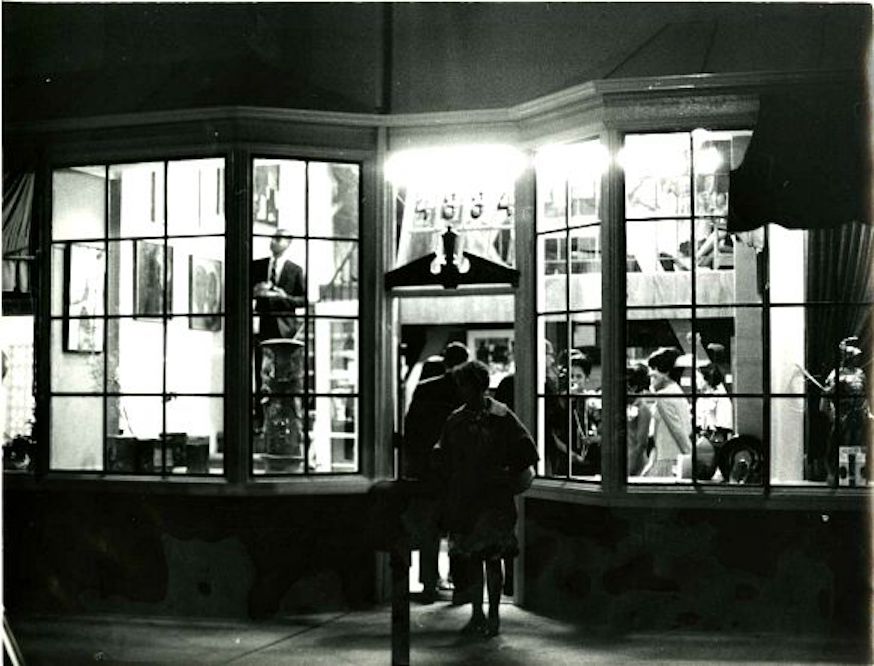
Opening night at Brockman Gallery, 1967. Image courtesy of the Brockman Gallery Archive. Image sourced from: http://bit.ly/1PPMFk2
“Erasure is what you normally think gentrification is,” says Ben Caldwell when I speak with him at Kaos Network in late 2016. I arrive to find the door to Kaos’s delightfully scrappy, colorful space uncharacteristically locked. Caldwell has used his lunch hours to visit Wells Fargo, he tells me upon his return. Bankers, racked by the most recent Wells Fargo scandal (the bank took out fake loans in customers’ names), expressed a desire to do something for the neighborhood. Caldwell suggested they stop refusing loans to people from presumably “at-risk” neighborhoods. “There’s a strong sense of redlining going on here,” says Caldwell.
In 1979, just after Caldwell made the film I&I: An African Allegory, he appeared on the UCLA student cable show “The View.” The host, nervous, young, and mustachioed, asked him about the future of black film and how he related to “Blaxploitation” movies like Shaft (1971). “The films that I’m planning on making … are going to be rooted in a strong historical sense,” responded Caldwell, speaking deliberately. “It’s not going to be in a slavery context. Shaft was made in a slave context. It wasn’t done as if you were once strong people who dealt with things […]. What we’re going to see is films that are more natural, realistic, and less self-conscious, and to some people probably a little more frightening.”
Just two years ago, Caldwell successfully lobbied the city to turn a stretch of 43rd Place between the Village and the park into The People’s Street, a car-free public space. Sankofa symbols line the asphalt — the bird reaching back to pick up an egg on its back means, in translation, “it is not taboo to fetch what is at risk of being left behind.” Now he is working with USC students on renderings of driverless cars, which will take imaginary future visitors around Leimert Village, showing them holograms of what used to be there: who played music, made art, or gathered where – a way to escape the erasure gentrification brings.
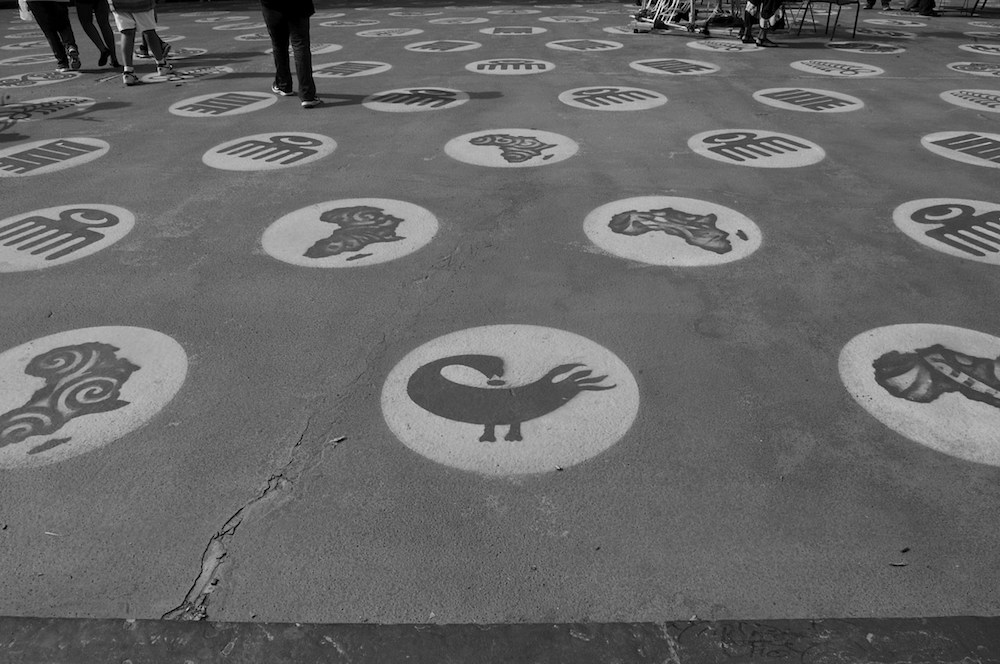
Sankofa bird on The People’s Street. Image courtesy Sahra Sulaiman/Streetsblog L.A.. Image sourced at: http://bit.ly/2xyNqjE
In the two-and-a-half years since it opened, A+P has hosted a range of shows: curator Jamillah James, on behalf of the Hammer, organized an impressive retrospective of local John Outterbridge’s work; and a group painting show called A Shape that Stands Up, about the crossovers between painting and sculpture. Since the Hammer’s grant period ended, shows have been done in collaboration with the Rose Museum’s Christopher Bedford, who also co-curated the US Pavilion in Venice. The most memorable art experiences I’ve had in the neighborhood happened elsewhere, however, during Kaos Network’s Middle Passage parade or an anniversary party at The World Stage. These experiences conveyed a generosity and presence unhindered by preoccupations with professional importance.
Dwight Trible had been telling me on the phone about The World Stage’s history before I attended a concert in spring 2015, in honor of the Stage founder Billy Higgins’s birthday. I could imagine, upon hearing him and his peers pay tribute to their mentors, how he felt when he first heard Horace Tapscott perform at The World Stage in 1992, not long after he’d joined the Pan Afrikan People’s Arkestra. As he told historian Steve Isoardi:
It was so intense. It was too much for my senses to handle. […] I said ‘Man, who is this genius that we’ve got in this neighborhood?’ When he got finished I was exhausted.
After 25 years at 4344 Degnan, The World Stage carted everything across the street, to a building owned by BarKochba Botach, an arms dealer who helms Botach Tactical and owns a few local buildings. They started hosting concerts right away. “Right now the vibe is so beautiful,” says Trible, when I meet him at an Ethiopian restaurant in Fairfax Village. “Nobody needed a chance to be distracted by nostalgia.” He tells me his board has been pressuring him to change The World Stage, professionalize it – perhaps make it look a bit more like A+P, with its white walls and understated exteriors. He dismisses such aspirations. “We want to grow and take this thing to the world but who we are is great and that’s good enough,” he says. “Our strength is our grassroots.”
























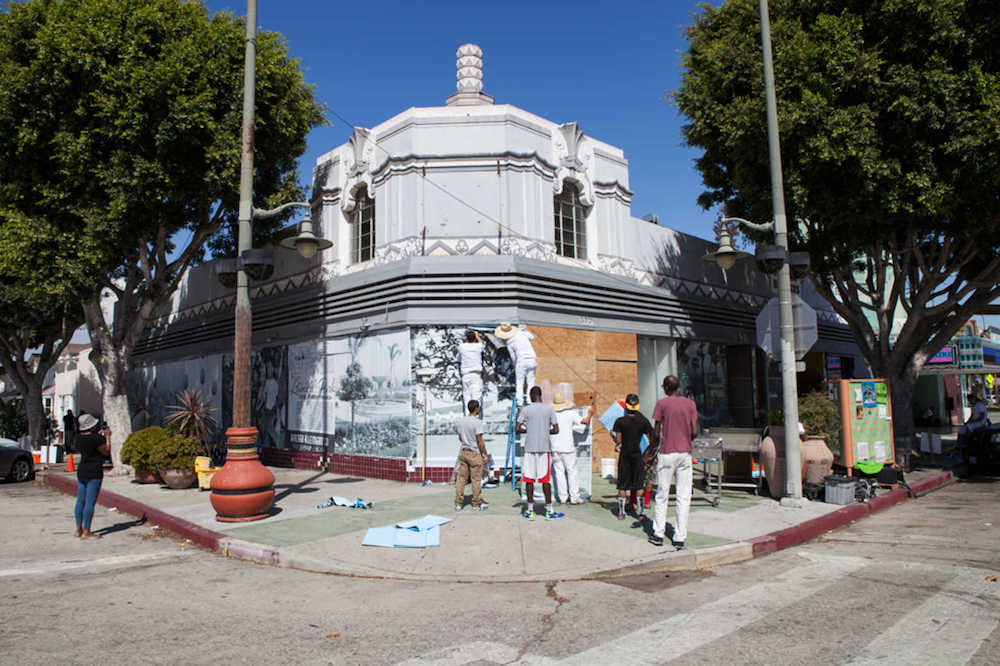
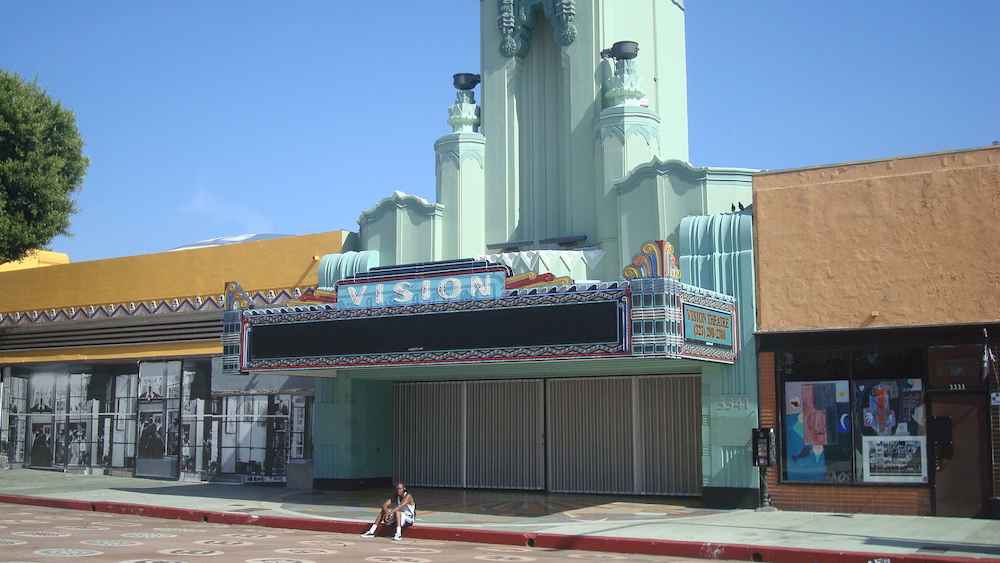
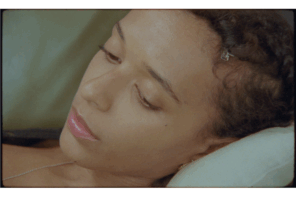


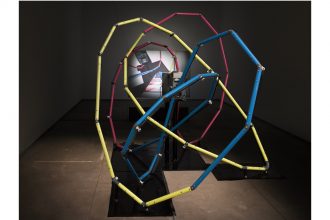
Finally read this. Officially registering my suspicion of a piece of investigative journalism that doesn’t include the voice or perspective of any of the Black artists or curators whose work they are “investigating.”
And because I check facts, I looked into that arms dealer who is now renting space to The World Stage, apparently local activists have been trying to get that gun store to leave for decades!
I do not doubt that A+P is speeding up the rate of displacement in this neighborhood so critique is necessary, but talking about a systemic issue and deciding to only name check a Queer Black artist/organizer in the headline is suspect.
suspect? you’re deluded. the piece fulfills a broad quotient of fact-based reality. I’ve known the queer Black artist/industrialist in question for over 25 years. Bradford knew I managed Brockman Gallery just that long ago, that I know the Davis brothers very well, like family. that I grew up on Degnan (11th Ave) in West Adams. did he call or consult me for AP’s first research journal? No.
the issue here is the disconnect between purpose and desire, the willingness to sacrifice openness and honesty for personal gain and notoriety. it is a sad bi-product of selfishness, stubbornness and the voracious need for more, bigger and presumably better – the ongoing product of an unhindered, well-funded and staffed art career that, viewed in traditional terms, is quite rarified though hackneyed in its hurry, its paranoid posture to stay ahead of the curve on its meteoric rise to the top.